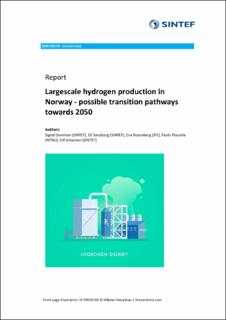Largescale hydrogen production in Norway - possible transition pathways towards 2050
Research report
Published version
Date
2020Metadata
Show full item recordCollections
- Publikasjoner fra CRIStin - SINTEF AS [5801]
- Rapporter fra SINTEF Community [790]
- Rapporter fra SINTEF Digital [299]
- SINTEF Community [2248]
- SINTEF Digital [2501]
Abstract
The report presents a case study where qualitative research framed within transition studies and the multi-level perspective (MLP) is used to discuss the role Norwegian hydrogen production may play in sustainable energy transition towards 2050. Ongoing initiatives and stakeholder perspectives on drivers and barriers are discussed. The focus is on the interaction between wider socio-political and market trends and national regime developments, and how this influences the scope for hydrogen production and deployment. The qualitative results are held up against the findings from model-based assessment of two transition scenarios. Our main finding is that hydrogen may be a key to reach the national climate targets. While hydrogen from natural gas with CCS has been associated with the largest potential, the shift towards a renewable and more distributed energy system is opening new opportunities and roles for hydrogen from electrolysis. The hydrogen industry is growing, but still fragmented, and calls for national coordination. Whereas economic and technological barriers have received most attention, the social acceptance of hydrogen as a sustainable zero-emission solution is a critical factor. The transition is currently at a critical tipping point. Systems thinking and increased focus on sociotechnical interactions are required to unleash the market.
